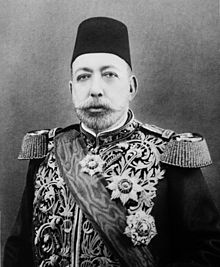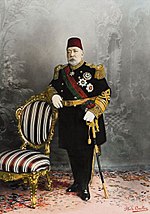Mehmed V
| Mehmed V | |
|---|---|
| Caliph of Islam Amir al-Mu'minin Sultan of the Ottoman Empire Custodian of the Two Holy Mosques | |
 Official portrait of Mehmed V, 22 July 1913 | |
| 27th Caliph of the Ottoman Caliphate 35th Ottoman Sultan (Emperor) | |
| Reign | 27 April 1909 – 3 July 1918 |
| Sword girding | 10 May 1909 |
| Predecessor | Abdülhamid II |
| Successor | Mehmed VI |
| Grand Viziers | |
| Born | 2 November 1844 Topkapı Palace, Constantinople(present day Istanbul),[1] Ottoman Empire |
| Died | 3 July 1918 (aged 73) Yıldız Palace, Constantinople(present day Istanbul), Ottoman Empire |
| Spouses | Kamures Kadınefendi Dürriand Kadınefendi Mihrengiz Kadınefendi Nazperver Kadınefendi Dilfirib Kadınefendi |
| Issue | Şehzade Mehmed Ziyaeddin Şehzade Mehmed Necmeddin Şehzade Ömer Hilmi Refia Sultan |
| Dynasty | Osmanli (Ottoman) |
| Father | Abdülmecid I |
| Mother | Gülcemal Kadınefendi |
| Religion | Sunni Islam |
| Tughra |  |
Mehmed V Reshad (Ottoman Turkish: محمد خامس Meḥmed-i ẖâmis, Template:Lang-tr or [Reşat Mehmet] Error: {{Lang}}: text has italic markup (help)) (2 November 1844 – 3 July 1918) was the 35th Ottoman Sultan. He was the son of Sultan Abdülmecid I.[2] He was succeeded by his half-brother Mehmed VI.
Birth

He was born at Topkapı Palace, Istanbul.[1] Like many other potential heirs to the throne, he was confined for 30 years in the Harems of the palace. For nine of those years he was in solitary confinement. During this time he studied poetry of the old Persian style and was an acclaimed poet. On his ninth birthday he was ceremoniously circumcised in the special Circumcision Room (Sünnet Odasi) of Topkapı Palace.
Reign

His reign began on 27 April 1909, but he was largely a figurehead with no real political power, as a consequence of the Young Turk Revolution in 1908 (which restored the Ottoman Constitution and Parliament) and especially the 1913 Ottoman coup d'état, which brought the dictatorial triumvirate of the Three Pashas to power.
Mehmed V's most significant political act was to formally declare jihad against the Entente Powers (Allies of World War I) on 11 November 1914, following the Ottoman government's decision to join the First World War on the side of the Central Powers.[3] He was actually said to look with disfavor on the pro-German policy of Enver Pasha.[4]
This was the last genuine proclamation of jihad in history by a Caliph, as the Caliphate lasted until 1924. The proclamation had no noticeable effect on the war, despite the fact that many Muslims lived in Ottoman territories. The Arabs eventually joined the British forces against the Ottomans with the Arab Revolt in 1916.

Mehmed V hosted Kaiser Wilhelm II, his World War I ally, in Constantinople on 15 October 1917. He was made Generalfeldmarschall of the Kingdom of Prussia on 27 January 1916, and of the German Empire on 1 February 1916.
Death
Mehmed V died at Yıldız Palace on 3 July 1918 at the age of 73, only four months before the end of World War I.[5] Thus, he did not live to see the downfall of the Ottoman Empire. He spent most of his life at the Dolmabahçe Palace and Yıldız Palace in Istanbul. His grave is in the historic Eyüp district of the city.
Decorations and awards
- Ottoman orders
Mehmed V was Grand Master of the following Ottoman Orders:
 Grand Master of the Order of the Crescent
Grand Master of the Order of the Crescent Grand Master of the Order of Nichan Iftikhar
Grand Master of the Order of Nichan Iftikhar Grand Master of the Order of the Medjidie
Grand Master of the Order of the Medjidie Grand Master of the Order of Osmanieh
Grand Master of the Order of Osmanieh
- Foreign orders and decorations
Knight of the Military Order of Max Joseph (Bavaria)
Family life
First marriage and issue

He married firstly at Constantinople, Ortaköy Palace, on 30 September 1872 to Azerbaijani HH Kamures Kadınefendi (Ganja, Caucus, 5 March 1855 – Kuruçesme, Istanbul, 30 April 1921), and had:
- Prince Mehmed Zia ud-din Effendi (26 August 1873 – 30 January 1938), married four times and had two sons and six daughters.
Second marriage and issue
He married secondly at Constantinople, Ortaköy Palace, on 10 October 1876 to Georgian HH Dürriand Kadınefendi (Kars, Caucus, 16 May 1860 – Istanbul, 17 October 1909), and had:
- Prince Mahmud Najim ud-din Effendi (23 June 1878 – 27 June 1913), unmarried.
Third marriage and issue
He married thirdly at Constantinople, Ortaköy Palace, on 4 April 1887 to HH Mihrengiz Kadınefendi (Adapazarı, 15 October 1869 – Alexandria, 12 December 1938 and buried in Cairo), and had:
- Prince Ömer Hilmi Effendi (2 March 1888 – 2 November 1935), married three times and had one son and one daughter.
Fourth marriage and issue
He married fourthly at Constantinople, Ortaköy Palace, in 1888 to HH Nazperver Kadınefendi (1870 - Istanbul, 1930) and had:
- Princess Refia Sultan (1888 – 1888).
Fifth marriage
He married fifthly at Constantinople, Ortaköy Palace, in 1907 to HH Dilfirib Kadınefendi (1890 - Istanbul, 1953) without issue.
See also
References
- ^ a b The Encyclopaedia Britannica, Vol.7, edited Hugh Chisholm, (1911), 3; "Constantinople, the capital of the Turkish Empire..".
- ^ Abdulmecid, Coskun Cakir, Encyclopedia of the Ottoman Empire, ed. Gábor Ágoston, Bruce Alan Masters, (Infobase Publishing, 2009), 9.
- ^ Lawrence Sondhaus, World War One: The Global Revolution, (Cambridge University Press, 2011), 91.
- ^ Chisholm, Hugh, ed. (1922). . Encyclopædia Britannica (12th ed.). London & New York: The Encyclopædia Britannica Company.
- ^ Mehmed V, Selcuk Aksin Somel, Encyclopedia of the Ottoman Empire, 371.
External links
![]() Media related to Mehmed V at Wikimedia Commons
Media related to Mehmed V at Wikimedia Commons
